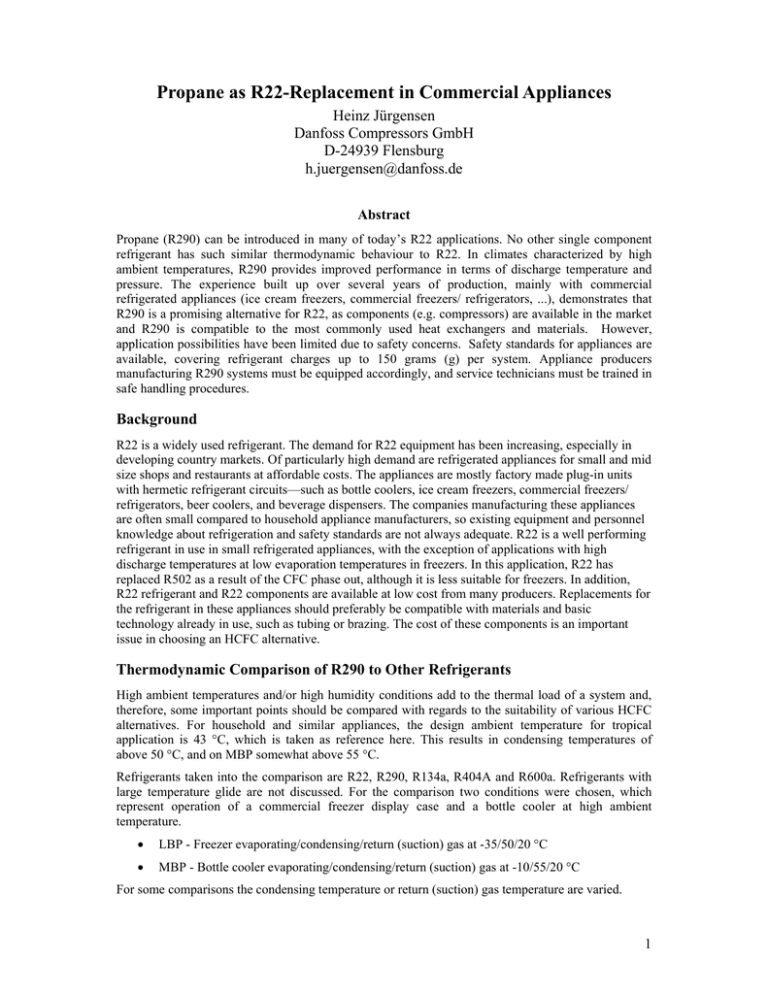Propane as R22-Replacement in Commercial Appliances
advertisement

Propane as R22-Replacement in Commercial Appliances Heinz Jürgensen Danfoss Compressors GmbH D-24939 Flensburg h.juergensen@danfoss.de Abstract Propane (R290) can be introduced in many of today’s R22 applications. No other single component refrigerant has such similar thermodynamic behaviour to R22. In climates characterized by high ambient temperatures, R290 provides improved performance in terms of discharge temperature and pressure. The experience built up over several years of production, mainly with commercial refrigerated appliances (ice cream freezers, commercial freezers/ refrigerators, ...), demonstrates that R290 is a promising alternative for R22, as components (e.g. compressors) are available in the market and R290 is compatible to the most commonly used heat exchangers and materials. However, application possibilities have been limited due to safety concerns. Safety standards for appliances are available, covering refrigerant charges up to 150 grams (g) per system. Appliance producers manufacturing R290 systems must be equipped accordingly, and service technicians must be trained in safe handling procedures. Background R22 is a widely used refrigerant. The demand for R22 equipment has been increasing, especially in developing country markets. Of particularly high demand are refrigerated appliances for small and mid size shops and restaurants at affordable costs. The appliances are mostly factory made plug-in units with hermetic refrigerant circuits—such as bottle coolers, ice cream freezers, commercial freezers/ refrigerators, beer coolers, and beverage dispensers. The companies manufacturing these appliances are often small compared to household appliance manufacturers, so existing equipment and personnel knowledge about refrigeration and safety standards are not always adequate. R22 is a well performing refrigerant in use in small refrigerated appliances, with the exception of applications with high discharge temperatures at low evaporation temperatures in freezers. In this application, R22 has replaced R502 as a result of the CFC phase out, although it is less suitable for freezers. In addition, R22 refrigerant and R22 components are available at low cost from many producers. Replacements for the refrigerant in these appliances should preferably be compatible with materials and basic technology already in use, such as tubing or brazing. The cost of these components is an important issue in choosing an HCFC alternative. Thermodynamic Comparison of R290 to Other Refrigerants High ambient temperatures and/or high humidity conditions add to the thermal load of a system and, therefore, some important points should be compared with regards to the suitability of various HCFC alternatives. For household and similar appliances, the design ambient temperature for tropical application is 43 °C, which is taken as reference here. This results in condensing temperatures of above 50 °C, and on MBP somewhat above 55 °C. Refrigerants taken into the comparison are R22, R290, R134a, R404A and R600a. Refrigerants with large temperature glide are not discussed. For the comparison two conditions were chosen, which represent operation of a commercial freezer display case and a bottle cooler at high ambient temperature. • LBP - Freezer evaporating/condensing/return (suction) gas at -35/50/20 °C • MBP - Bottle cooler evaporating/condensing/return (suction) gas at -10/55/20 °C For some comparisons the condensing temperature or return (suction) gas temperature are varied. 1 Table 1 provides a summary of the thermodynamics of R290 as compared to R22, R134a, R404A, and R600a under the chosen conditions. Table 1: Performance of refrigerants at discussed conditions Item R22 Pressure o Pressure ratio low back pressure (LBP) o Discharge temperature Volumetric capacity + Capacity loss o COP o Legend: 0 = acceptable; + = good; - = problematic. R290 R134a R404A R600a o + + + o o + + o o o + + - + + o + Summing up the different thermodynamic aspects, R290 could be used as replacement for R22 in many commercial refrigerated MBP and LBP applications. R290 is the only candidate, which comes close to R22, in some aspects even outperforming it. The lower pressure ratio and lower discharge temperature even allow for use in certain applications where R22 is problematic. Bringing the alternative to market R290 has a long history in refrigeration. It has been in use since before CFCs were developed and was re-introduced for use in heat pumps after the CFC phaseout. Its thermodynamic data, efficiency, and material compatibility are well known. In some countries, appliance manufacturers and food producers began using R290 as a replacement for R404A or R134a in appliances shortly after 2000, due to environmental concerns. The increasing use of the flammable refrigerant isobutane (R600a) in household appliances demonstrated that it is possible to safely use flammable refrigerants, thus opening the possibility to use R290 in other systems. Indeed, compressors developed specifically for R290 have been available since 2000. However, retrofitting R22 compressors to R290 often results in serious reliability problems for the appliance manufacturers. Commercialized applications with propane The commercial applications listed in Table 2, are sorted roughly in order of number of sold units. The large market of unitary air conditioners is not listed, as Danfoss is not producing propane compressors for such units. The market demand for R290 compressors has been growing over the years, but remains small relative to R134a or R404A. Table 2: Applications with small hermetic systems Bottle cooler Ice cream freezer/commercial freezer Commercial refrigerator Beer cooler Beverage dispenser Dehumidifier Electronics cooling Heat pump LBP=Low Back Pressure MBP=Medium Back Pressure HBP=High Back Pressure MBP LBP MBP MBP MBP HBP HBP HBP In short, the major applications for propane compressors will be in MBP and commercial and ice cream freezers with LBP. Unfortunately, increased capacity typically also requires increased refrigerant charge. Due to the limitations in safety standards, the cooling capacity is therefore limited, as long as standard system components are used. In 2000, Danfoss Compressors introduced a combined LBP/MBP compressor range for propane ranging from 5 to 21 cm3. This range has been extended to 3 cm³, and by 12 to 21 cm³ pure LBP compressors with optimized valve systems, thereby increasing capacity. 2 Since compressors for propane are available, Danfoss Compressors together with customers have tested this refrigerant in several equipment types of different sizes, namely: • • • • • • Bottle coolers Beer coolers Commercial freezers Beverage dispensers Small ice-cream freezers Display island freezers and coolers Comparisons of propane compressors have been primarily made against R134a and R404A compressors, and to a lesser extent, R600a and CO2 compressors. The findings are that R290 performed about the same as R134a, and typically better than R404A. Efficiency improvements were in the range of 0 to 10 %. In some cases, modifications were needed to reduce the charge size of R290 below 150 g. This was achieved by using different evaporator tube sizes and/or changes to capillary expansion. The capacity penalty of R290 relative to R404A in LBP applications was less than predicted, probably because of the lower pressure ratio of R290. Safety considerations Safety standards have been developed for the use of hydrocarbons, including leakage simulation tests and specifications for several electrical components which may come into contact with leaking refrigerants. The following set of international standards, from the International Electrotechnical Commission, on electrical safety contains rules for the design and testing of appliances operating with flammable refrigerants: • IEC 60335-2-24: Household refrigerators and freezers • IEC 60335-2-34: Motor compressors • IEC 60335-2-89: Commercial refrigerators and freezers • IEC 60335-2-40: Heat pumps, air conditioners and dehumidifiers IEC 60335-2-24 and IEC 60335-2-89 currently restrict the charge size for commercial refrigerators and freezers and household refrigerators and freezers to 150 g of flammable refrigerant, respectively. This charge amount is considered to be safe if the appliance itself is tested for safety. The standard does not establish safety guidelines for units with a propane charge greater than 150 g. Thus, the use of R290 is normally limited to 150 g, which corresponds to a R22 charge size of 300-350 g. Guidelines for designing appliances for flammable refrigerants are available to meet the requirements of these safety standards. Many commercial refrigerated appliances use components suitable for flammable refrigerants, already meeting safety standard requirements. Larger appliances, which require a larger refrigerant charge size, need major modifications to be operated with 150 g, particularly to the evaporator volume and the liquid receiver used with thermostatic expansion valves, which determine the charge amount required. To reduce the charge size to 150 g, capillary expansion systems and small evaporator inner volumes must be applied, which requires significant development effort for larger appliances. Danfoss considers working according to safety standards for use of R290 essential and strongly recommends obtaining third party approval for the appliances and manufacturing, testing and charging appliances (e.g., TÜV), even in countries where approvals are not mandatory. In some countries, additional laws may apply to the use of flammable refrigerant. This must be investigated by the appliance manufacturer. In addition, safe work during servicing of appliances with flammable refrigerant requires well-trained and educated after-market service personnel. Depending on the country, the service technicians will 3 have very different backgrounds and education levels. Therefore, in terms of handling flammable refrigerants, this education must be brought to a safe level. Impacts of switch to alternative The production costs for appliances being converted from equivalent HCFC charge and using up to 150 g R290, might slightly increase due to safety standard requirements. The actual cost increase depends on the changes necessary, and can often be minimized by some redesign of the equipment. The major impact on the producer will be the cost of equipment for leakage testing, charging, and safety installations in the factory. The cost of the necessary equipment is dependent on the production volume. The energy efficiency and reliability of the appliance using R290 is expected to be equivalent to or better than that of equipment using R22. Because R290 has no ODP and a very low GWP, assuming that R290 has the same energy efficiency as R22, the environmental impact is reduced. Based on estimated charge sizes and leak rates, emission savings are estimated to be 25 tonnes of R22 per 100,000 appliances. 4





